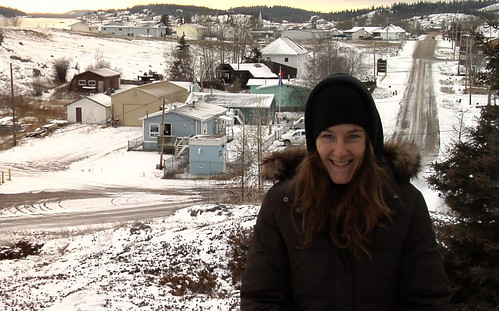This is about a film which was nominated in three categories at the recent Rencontres internatinales du documentaire de Montreal, and which I saw at Cinema Parallèle the other day. Very much à propos, as the Copenhagen climate change conference enters the real negotiating stage. The film, H2Oil by Shannon Walsh (Loaded Pictures), is about the incredibly wasteful and polluting oil sands industry in Northern Alberta and its impact on both people and the environment. It struck me how similar this film is to my own first films, somewhere midway between a journalistic ‘dossier noir’ and a dramatically structured film. The footage of the tar sands is depressingly impressive, and some of the characters are excellent, including a doctor who shows real civil courage and some very touching aboriginal people from the most affected community, Fort Chipewayan.
I asked Shannon a couple of questions.

Shannon Walsh, the director of H2Oil.
· This is a huge subject which one would think would attract a lot of television journalists and filmmakers – have there been other films?
I was really shocked that there weren’t really any feature length films on the subject. There had been a doc aired on CBC called “Tar Sands: The Selling of Alberta” while we were still filming, and there were a couple of pro-industry pieces that had been done, but there really wasn’t much. I felt a lot of responsibility to try to tell the story in as complete a way as I could without losing the human dimension because so many people I met had no idea what was happening in the tar sands.
· And how did you get the funding to do yours in what I presume to be a competitive context?
I think we were in the first wave of projects coming through on the subject looking for funds, but to be honest it is such a complex and difficult subject to tackle. With the help of some supportive initial private funding we made our first trips out to Alberta and put together a short demo that I think reflected the film we wanted to make. That demo I think was a big part of how we set ourselves apart and were able to show that we could handle the subject matter with a sensitive approach.
· Excellent animation, how did you work on that?
I really wanted to find a way to get across some of the tough informative details in a fun and engaging way. I loved the work James Braithwaite had done on “I Met the Walrus” and I thought it would work for H2Oil, so we got in touch with him to see if he was interested. James brought in the excellent animators Dale Hayward and Sylvie Trouve, and we brainstormed together around the content I wanted to put in each of the three animations. I had basic points of what I felt needed to be put together in the animations then I set about writing the scripts. James did the initial drawings and Dale and Sylvie brought them to life. We met several times to tighten and revise the sequences, as the initial drafts became more formal drawings, and were finally. It was amazing working with such talented, smart creative people who really understood what I wanted to do.
· Which were your biggest challenges?
There were a lot of challenges: Getting access to the government and industry. Trying to tell a rounded story that still got to the heart of the issues. Weaving all these very complex technical details, and making an argument without being didactic and losing the human story….END.
RCI, the International arm of the CBC, has announced a competition called Roots, calling for videos under 8 minutes. Sounds like a good challenge ! Rest here: http://roots.rcinet.ca/
Thanks to Jessica Berglund for the help with this post.
![Tar sands.27[1]](http://farm3.static.flickr.com/2670/4184804629_677c21e34c.jpg)